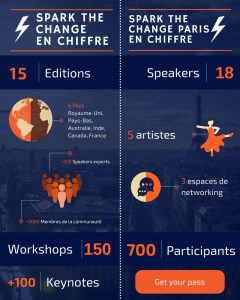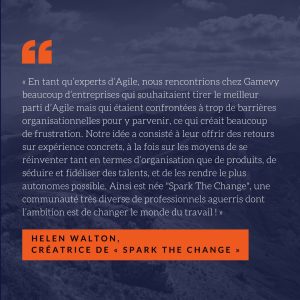
During the DevExperience conference on the 25th of March, we sat down with one of the key speakers, Lisette Sutherland, to discuss the ways in which technology advancements, and VR in particular, will impact people’s lives and working habits.
Beaglecat: Could you please tell us something about yourself and the company you run?
Lisette Sutherland: I am the director of my own company, Collaboration Superpowers. Myself and other licensed Facilitators give online and in-person workshops to help companies work better together remotely. I am also the remote team manager at a company called Happy Melly – a global network of businesses that are focused on making people happier at work (included are Management 3.0, my company, LeanChange.org, Improv Agility, and others).
BC: Do you think in 5-10 years we will have offices like we have today or do you think everyone will work remotely?
L.S.: Technology is making the traditional ”9 to 5” schedule unnecessary and less attractive for more and more people, especially the younger generation. The most important thing is working from where you are the most productive. Some people work better on the road, some at the beach, some from the office, some from the comfort of their own home – everyone should choose what works best for them.
BC: Do you think that we will be able to work using Virtual Reality in the near future?
L.S.: They’re already doing it. Virtual worlds have existed for more than 20 years now. People are going to school and earning degrees in VR. People are going to conferences in VR. The military uses VR for simulations.
The only issue is that navigating in VR is very difficult, it’s like learning to play the piano. That’s why it’s not so popular. It’s worth trying it out to see what it’s like to be in a virtual world. For example, you can create an account in SecondLife. When you log in, you are placed on a “newbie beach”, literally a beach for new people. Then you have to learn how to move your character and interact with the world and find your way to the place you want to go (like a conference).
BC: I am guessing that 10 years from now this is going to grow. How do you think this is going to impact us?
L.S.: One thing to be careful of is getting enough real life social activity. Technology has an addictive, unhealthy side to it. Each person needs to create healthy boundaries for themselves. The exciting thing is that with technology people can get together from anywhere in the world and solve interesting and challenging problems. I used to work for a company that was developing an online project management tool. The CEO was building it because he wanted to solve the problem of aging. He was frustrated that longevity scientists all over the world couldn’t properly collaborate together and easily share data. So he set out to build a tool they could use to collaborate at a distance. For me it was an ‘aha’ moment. I realized that if we could get the right people together, we could do great things like curing cancer or stopping global warming, or aging.
BC: What do you think the world will look like in 20 years?
L.S.: It is hard to say because if you asked someone 20 years ago what the future would look like today, they would have probably envisioned it completely different.
I recently held a workshop in Lebanon from the Netherlands using a robot – so I beamed into Lebanon, talked to the people as if I were there in the room. Drivable robots are also available now. For example, my friend from Canada beamed into one of these robots in Las Vegas, I beamed into another one from the Netherlands, and we both attended a conference as if we were in Las Vegas together. We visited booths, saw a presentation, had tea together, all from the comfort of our own living rooms. If you had told me I’d be doing that 20 years ago, I wouldn’t have believed you.
When borders dissolve, the possibilities really start to open up. For example, someone in Romania can work with a team in San Francisco, or a team in Vietnam. Sometimes you need that one guy or girl with that unique skill that nobody has – and what if that girl is not from the city you are working in?
There are also many people in the past that have been limited by location. For example, military spouses, disabled people or retired people. Military spouses have a hard time finding stable work because they are constantly moving. And there are many people who have retired, but still want to practice their craft or continue working somewhere. Because of remote technologies, there’s a whole new pool of people to choose from for the work that needs to get done.
BC: So do you think that in the future robots will do everything?
L.S.: I think robots should do the boring work and humans should do the interesting work. And maybe in the future not everybody will have to work full time, and maybe that’s ok. Do we have to work 40 hours a week? Why? That was a random number set by Henry Ford. Maybe we could work 20 hours a week and the rest of the time we could travel, or work on our hobbies, or spend time with our family, or just do whatever we want.
BC: What do you think is the influence of technology on productivity?
L.S.: Recently, I see a lot of companies struggling to go from being time-oriented to results-oriented. When we can work from anywhere, the focus is more on what you get done, not how long it takes you to do it. Spending the whole day at the office only means that you spent the whole day in the office, not that you were productive.
Summing up, the good thing about technology is that it dissolves borders but it requires a new way of working. What it means to be “present” at work is changing, and it’s opening a lot of new opportunities. A lot has happened in the last five years. I encourage people to explore some of the new tools and think about how they can use it in their own lives. My Work Together Anywhere Workshop is a great place to start.
Lisette Sutherland is Director atCollaborationSuperpowers.com, a company that helps teams work together from anywhere. She is also the remote team manager for the all-remote freelance team at Happy Melly.





 « Spark the Change » : décrypter et inspirer les bonnes pratiques
« Spark the Change » : décrypter et inspirer les bonnes pratiques 

